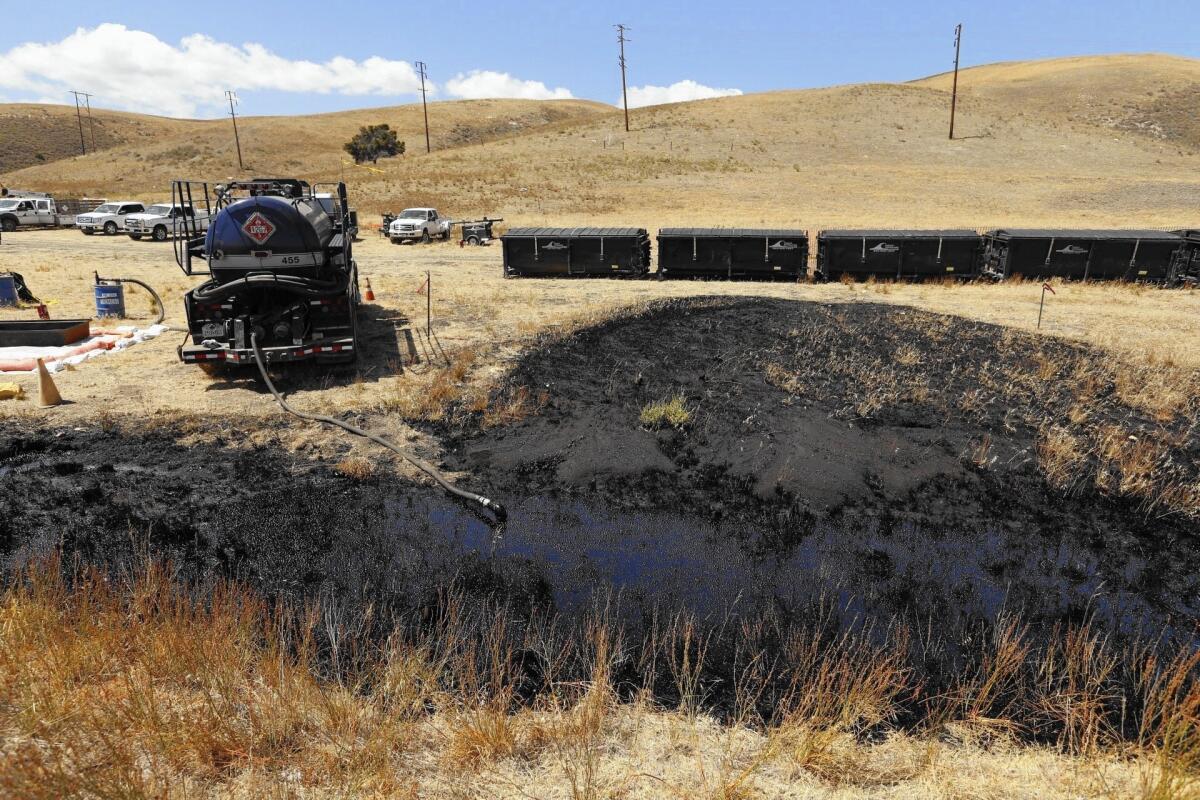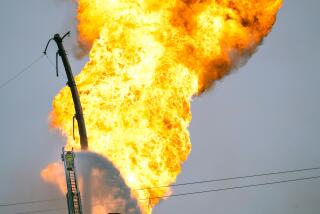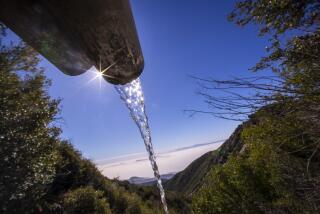Feds order company involved in California oil spill to test, study pipe

The oil pipeline rupture at Refugio State Beach may have spilled as much as 105,000 gallons of crude, authorities said.
Federal regulators on Friday ordered the company responsible for an oil spill on the Santa Barbara County coast to remove a portion of the ruptured pipeline for inspection, as scientists assessing the damage warned that the crude could harm the marine environment for years.
As investigators try to determine what caused the rupture, officials said that the pipeline, purchased by Plains All American Pipeline in 1998, was the only large transmission line in Santa Barbara County not fitted with an automatic shutdown valve.
Such a safety device would have automatically shut down the pipeline, overriding human operators.
County officials require the device, but a court ruling in 1988 allowed the pipelineâs former owners to operate without it. Some in the industry say that because of frequent pressure changes in oil lines, the override valves too often trigger false alarms.
âThey felt that we were an unnecessary set of eyes they didnât want to pay for,â said Kevin Drude, who heads Santa Barbara Countyâs energy division, adding that the settlement in the court case gave the county the right to inspect and regulate other aspects of the pipelineâs operations.
âI like to be more conservative,â Drude said. âI would rather be warned and not rely on human error.â
Fridayâs order by the Pipeline and Hazardous Materials Safety Administration requires Plains to send the section of pipe that ruptured Tuesday out for metallurgical testing to determine the condition of the pipe when it failed and sent about 21,000 gallons of crude oil into the ocean.
No fines were issued, but the order requires the company to flush out the rest of the pipelineâs oil to prevent further damage. Plains must also have an outside group review past pipeline test results, said Linda Daugherty of the pipeline safety administration.
State and federal officials, meanwhile, continued to oversee hundreds of workers shoveling and sopping up heavy crude that has coated several miles of shoreline and more than a dozen vessels corralling and skimming it from the water. They said the cleanup could take months.
The spill has prompted beach, campground and fishery closures that will stretch beyond the Memorial Day weekend.
But the environmental effects could persist for years or decades as the oil is dispersed through the ocean food chain, scientists said. Plains â which has a history of pipeline safety and maintenance infractions â will have to pay for the cleanup and repair environmental damage and is likely to face penalties under U.S. pollution laws, legal experts say.
On Friday, two dozen government scientists walked the beaches near the spill to tally injured wildlife, collecting information that will determine how much money Plains All American Pipeline will be assessed.
âThe public had these things taken away from them,â said Greg Baker, an ecologist with the National Oceanic and Atmospheric Administration and a coordinator for the assessment, which takes into account everything from dead fish to lost beach access. âThere is a value to that.â
Baker and fellow scientists noted and photographed even the smallest snails and squid eggs, encountering fist-size globs of tar on the sand.
So far, six oil-covered brown pelicans have been taken to the Los Angeles Oiled Bird Care and Education Center in San Pedro to be cleaned and rehabilitated, with two more of the cold and distraught birds on the way, said Eric Laughlin, a spokesman for the state Department of Fish and Wildlifeâs Office of Spill Prevention and Response.
At the rehabilitation center, four women in yellow impermeable suits towered over one of the pelicans as it sat quietly in a blue tub filled with water and dish soap. One of the workers for International Bird Rescue held the birdâs beak as another gently scrubbed away the oil with a green toothbrush.
âThey are very heavily oiled, completely saturated,â said Christine Fiorello, a UC Davis veterinarian.
An emaciated sea lion with oil on its body, face and flippers was taken to SeaWorld San Diego late Thursday and evaluated and cleaned. Veterinarians and animal care specialists are âcautiously optimistic about her chances for survival and recovery,â said park spokesman Kelly Terry.
The ruptured pipeline near Refugio State Beach released as much as 105,000 gallons of oil, with about 21,000 gallons flowing into the ocean. Plains Pipeline said it shut down the 11-mile line manually after detecting mechanical problems.
Federal records show Plains has accumulated 175 safety and maintenance infractions since 2006.
The U.S. Environmental Protection Agency sued the company in 2010 over a series of 10 oil spills in Texas, Louisiana, Oklahoma and Kansas.
The company was accused of spilling 273,420 gallons of crude oil, some of which made its way into rivers. The firm signed a consent decree requiring it to pay $3.25 million in fines and spend $41 million to upgrade its pipelines.
Last year a pipeline owned by the company leaked in Atwater Village. About 10,000 gallons of oil spewed out, some of it rising 20 feet in the air before raining down on a nearby strip club, forcing its evacuation.
Plains said Friday that it was abiding by the regulatorsâ order. In a statement, the company defended its safety record and said it had inspected the line that ruptured two times within the last three years.
âWe deeply regret that this release has happened,â Patrick Hodgins, senior director of safety and security, said in the statement. âWe will do everything in our power to make this right.â
Despite its relatively small size, the spill could cause significant harm to animals on the sea floor and near the shore, said Brice Semmens, a fishery scientist at Scripps Institution of Oceanography who was not involved in the on-the-ground damage assessment.
Some of the most vulnerable sea life are mussels, barnacles and other shellfish that are attached to the seafloor and rocks and are unable to move out of the way, Semmens said.
âThose organisms suffer 90%-plus mortality when theyâre exposed to oil,â Semmens said. âRecovery of those communities can take decades. Itâs not just a matter of a year and everything is back to normal.â
Back on the beach, researcher Dave Hubbard of UC Santa Barbaraâs Marine Science Institute said that images of struggling sea lions and oil-stained birds usually garner the most attention, but that oil can also harm smaller creatures at the base of the ocean food chain.
He took a photo of a distressed, oiled sea star that washed up on shore. He said it was still alive.
âProbably wonât be for much longer,â said UCSB biologist Jenny Dugan.
Panzar reported from Santa Barbara, Cart and Barboza from Los Angeles. Times staff writers Brittny Mejia, Jack Dolan and Joseph Serna in Los Angeles and Tony Perry in San Diego contributed to this report.
For more California news, follow @JosephSerna and @julie_cart.
More to Read
Sign up for Essential California
The most important California stories and recommendations in your inbox every morning.
You may occasionally receive promotional content from the Los Angeles Times.












